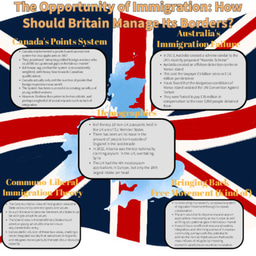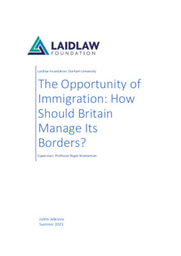Research Proposal: From Windrush to the Refugee Crisis: a Study of Britain's Borders
Research Objectives
- To analyse the implications of current and previous border legislation
- To identify key aspects of Windrush and the refugee crisis, relating them to socioeconomic and policy factors in the UK
Background and Rationale
In recent years there has been mass public discourse surrounding the UK’s borders. The Brexit campaign advocated to “take back control of its borders”, suggesting they lacked adequate regulation under the EU. Notions of a need for greater border control, stricter deportation laws and a battle against what has been referred to as an “invasion” have dominated mainstream political discourse and lead to a sense of hostility towards immigrants and refugees alike.
Nevertheless, it is inaccurate to state that government policy universally opposes the presence of refugees and immigrants. Most notably, the “Homes for Ukraine” scheme was introduced so that UK residents could support and house Ukrainian refugees amid international conflict. There appears direct contradiction between Suella Braverman’s invasion rhetoric and a governmental scheme to house refugees and pay for their visas, as well as the post-Brexit push for immigration from the commonwealth. Furthering the idea of contradiction, the Windrush scandal is the story of an exploitative government who welcomed thousands through the borders only to send some of them back years later. This project will explore the refugee crisis, with the aim of understanding why there exists such a contradiction in policy. It will analyse the tale of Windrush with reference to both law and politics and will explore the relevant legislation, before and after Brexit, as well as its implications.
Research Questions
What changes has the Nationality and Borders Act 2022 introduced? – analysis of the current legislation and what we can deduce about the UK’s stance on its own borders. Is there evidence from this legislation that the government has grown from Windrush and the current refugee crisis?
What role does the UK play in the refugee crisis? – in essence, does the state have a responsibility to help refugees? In what capacity should it be providing assistance? Has the UK itself caused displacement for which it should be held accountable?
What is the impact of Brexit and EU membership on UK borders? – addressing the idea of “taking back control” and the changes Brexit has made to the UK’s borders. Analysis of retained EU legislation and terms of the Withdrawal agreement regarding the UK’s borders.
Research Methodology
I aim to combine quantitative and qualitative means to conduct my research. Quantitative data sources include, but will not be limited to, border trends and immigration statistics. Government statistics are the most reliable forms of data about the UK’s borders. This form of data is reasonably comprehensive, however, data concerning illegal immigration is likely inaccurate as the government can only estimate these figures. In terms of qualitative resources, I will draw upon journals, news articles, books, blogs, interviews, legislation, and case law to analyse different perspectives to formulate and substantiate my own line of argument. It is important that I recognise statistical inaccuracies and bias throughout these sources; they do not always rely on statistics and can be used as tools to further an agenda or reinforce an opinion, as such these sources are not always objective. Though it is worth noting that opinions and bias are crucial to analysing societal attitudes towards border management.


Please sign in
If you are a registered user on Laidlaw Scholars Network, please sign in